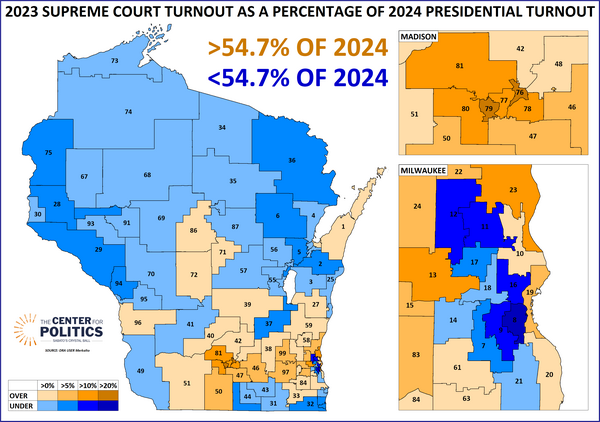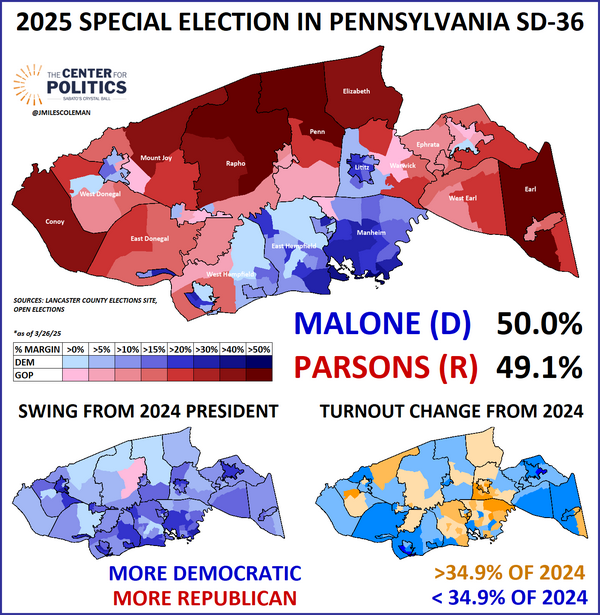KEY POINTS FROM THIS ARTICLE
— On Tuesday, Wisconsin voters will weigh in on yet another high-spending, high-stakes state Supreme Court race.
— Aided by a “higher propensity” voting coalition, the Democratic-aligned candidate may be a little better positioned there than the Republican-aligned candidate.
— Florida will see two House special elections next week, in Districts 1 and 6.
— Republicans should hold both deep red Florida seats, though FL-6 could be close.
— In Pennsylvania this week, Democrats defended their 102-101 majority in the state House and flipped a traditionally red state Senate seat in Lancaster County.
Wisconsin: Another banner state Supreme Court race nears
With a major swing-state judicial race and a pair of special House elections scheduled, this coming Tuesday night will probably be the most consequential night for election-watching until Virginia and New Jersey elect new governors in November.
In Wisconsin, Democrats—or, to be precise, Democratic-aligned justices—secured a 4-to-3 majority on the state’s nominally nonpartisan 7-member state Supreme Court in 2023. That year, Chief Justice Pat Roggensack, a conservative, retired after serving two ten-year terms. Democrats backed Milwaukee circuit court judge Janet Protasiewicz, who defeated former Justice Daniel Kelly, a conservative, by 11 points.
During the 2023 campaign, Republicans complained that Protasiewicz was too open about some positions that she’d take on the court if elected. For instance, she criticized Republican gerrymandering in the state and ran on abortion rights. Those complaints from Republicans were not unfounded: After the election, the liberal majority on the court threw out the state’s GOP-drawn legislative maps and, though no ruling has come out yet, seems likely to side against an 1840s-era statute that, if operative, would ban nearly all abortions in the state. To be fair, Republican-backed candidates have not had perfectly nonpartisan veneers, either—in Kelly’s case, after his time on the state Supreme Court, he advised the state Republican Party and was linked to the “fake elector” scheme during the aftermath of the 2020 election.
Though campaigns for Wisconsin state Supreme Court seats seemed headed in that direction for years, the 2023 campaign represented the nail in the coffin for the pretense of nonpartisanship, as one of our local contacts put it at the time. “The court is now the third chamber of the legislature,” he added. Though candidates do not run with partisan labels, the parties actively choose sides.
It is in that spirit that the 2025 race began very much where the 2023 race left off. Last year, Ann Walsh Bradley, a liberal who is currently the most senior member of the court, announced her intention to retire at the conclusion of her third term. Dane County Circuit Court Judge Susan Crawford consolidated Democratic institutional support while former state Attorney General Brad Schimel has the backing of Republicans, including President Donald Trump. The general slate of issues has not changed too much from 2023, although, as Democrats are “defending” this seat, a Schimel win would return the court back to a 4-3 conservative majority.
A possible national implication of a continued 4-3 liberal majority could be felt in the House: as court-approved legislative maps took effect last year, the thinking is that a new House map could come next. Currently, despite the state’s marginal nature, Republicans hold a 6-2 advantage in its House delegation. House Minority Leader Hakeem Jeffries (D, NY-8) said this week that a liberal majority could give Democrats a better map, while Schimel has repeatedly warned that a couple of GOP-held House seats would be in jeopardy if he loses.
As was the case with Protasiewicz two years ago, Crawford has outraised her GOP-aligned opponent, although a new twist for 2025 came with the involvement of a national figure: Elon Musk. Groups linked to the top Trump adviser and Republican megadonor have spent at least $14 million in the race, and Musk himself recently said that the court’s potential intervention in congressional redistricting motivated him to get involved. Though Sen. Ron Johnson (R-WI) seemed to preemptively credit Musk for a potential Schimel win, Democrats have worked to turn the race, at least to some degree, into a referendum on the polarizing tech billionaire. Meanwhile, on the left, Gov. JB Pritzker (D-IL), another billionaire, has become a major backer of the pro-Crawford coalition.
As of Wednesday, nearly 410,000 early in-person or absentee votes have been cast in the state, a number that falls in between what the 2023 Supreme Court race and 2024 presidential general saw at this point in the race. Wisconsin does not have a long-running history of early voting, so we are reluctant to read too much into the patterns that have emerged. That said, as in past years, it seems that Democratic Dane County (Madison) and the three Republican suburban “WOW” counties around Milwaukee County will be key. Those areas are leading the state in ballots counted so far and have generally punched above their weight in past state Supreme Court races.
Map 1 helps illustrate that past turnout dynamic. While the 2023 race was a high-turnout election for the standards of a state Supreme Court race, it was still just under 55% of what the 2024 presidential saw: Protasiewicz and Kelly combined for a little over 1.84 million votes while Trump and Kamala Harris together took almost 3.37 million.
Map 1 is broken down by assembly districts and considers 2023 turnout as a percentage of 2024 turnout in each district. In orange districts, 2023 turnout was more than 54.7% (the statewide figure) of 2024’s while the reverse is true in blue districts.
Map 1: Turnout by Assembly District in Wisconsin 2023 state Supreme Court vs 2024 presidential
(Right-click to enlarge)
One way to interpret Map 1 is that, in orange districts, turnout was more similar between the two elections. Notably, every district that contains a piece of Dane County is orange. ADs 76 and 79, which include parts of Madison proper, are the darkest orange districts on the map and both cast about 75% of their 2024 vote total in 2023, outpacing the statewide number by more than 20 percentage points. Similarly, districts that contain the WOW counties are various shades of orange.
Meanwhile, 58 of the 99 districts are some shade of blue. Much of the rural north falls into this category, though it does include population centers like the “BOW” counties (a stretch running from Green Bay to Oshkosh) and several districts that make up Milwaukee proper. In December, we highlighted those Milwaukee districts as part of our post-mortem of the presidential race in the state: though they are still solidly Democratic, these majority-minority districts moved toward Trump.
Though both color categories were mixed bags when it came to the partisan composition of their districts, Map 1 gives Democrats some reason for enthusiasm going into Tuesday. Orange districts, collectively, supported Harris by 5 points last year—her 52.6% two-party share was actually the same as Joe Biden’s from 2020. Blue districts, which could be considered “lower propensity” in this context, backed Trump by 3.2 points in 2020 and then by a larger 5.8 points last year. Trump’s improvement in those districts, therefore, enabled him to flip the state. But now Republicans are worried about a less favorable electorate: A recent polling memo from a group associated with Musk showing Schimel down 48%-43% suggested that more needed to be done in the closing days to activate Trump voters. The situation reminds us of several of last year’s Senate races, when Republicans were trying to match Trump’s share of the vote in polls. The difference, of course, is that Trump himself is not on the ballot this time.
Perhaps aided by their “higher propensity” coalition, Democrats have a better recent record in state Supreme Court races. Despite a bare majority on the court, pro-Democratic justices have won 3 of the last 4 contested races. In the 2018 and 2020 contests, liberals won by margins comparable to what Protasiewicz got in 2023, while Republicans staged a slight upset in 2019, with now-Justice Brian Hagedorn winning an open seat by half a percentage point. A Schimel win would also be at least a little bit of an upset.
Special elections in Florida
While Wisconsin’s state Supreme Court race will probably be the most consequential of Tuesday’s contests, two Florida districts will also hold special elections. Although we would hardly call them swing seats, the margins in the deep red pair of FL-1 and FL-6 will be worth watching.
In northwestern Florida, Escambia County (Pensacola) makes up a plurality of FL-1’s population, while the balance comes from a couple of other coastal counties that fall along what is sometimes colloquially referred to as the “Redneck Riviera.” The district’s member for much of the last decade was now-former Rep. Matt Gaetz (R), a pro-Trump provocateur known for his role in now-former Speaker Kevin McCarthy’s ouster. Gaetz was Trump’s original designee for the Attorney General job late last year—however, he withdrew himself from consideration and left Congress altogether. As an aside, this was also the district that Joe Scarborough held: Before his years as a staple on MSNBC’s morning programming, he arrived in Congress after the 1994 elections as a supporter of New Gingrich’s Contract with America. He flipped the seat after the retirement of conservative Democrat Earl Hutto, one of the many instances of Republican realignment down the ballot in the South in that era, In more recent years, FL-1’s vote has been remarkably consistent: since 2008, Republican presidential nominees have always carried the district with about two-thirds of the vote.
FL-6, which is located between Jacksonville and Orlando, has a somewhat more eclectic makeup. The district pairs several Atlantic coast cities, such as Daytona Beach and Flagler Beach, with some of the state’s interior exurbs. Compared to FL-1, FL-6’s trajectory has been more nuanced: according to Redistricter, in 2000 Al Gore narrowly carried this version of the district and in 2008, Barack Obama took a respectable 47%—but it has since shifted markedly to the right, and it gave Trump an even 30-point margin last year. The Democratic collapse in places like this has contributed to Florida’s transition from a purple state to a red state. The former occupant of the seat is now-National Security Adviser Michael Waltz—who was in hot water this week for his involvement in a certain group chat. Waltz himself replaced Gov. Ron DeSantis (R-FL) in Congress.
Though the Florida districts will be the first U.S. House-level special elections since last November, if their results are consistent with the preponderance of state legislative special elections that have taken place since then, Republicans will underperform Trump—although both districts are so red that an actual Democratic win in either would be a huge upset.
Though FL-1 is, by its partisan lean, a redder district, our thinking at first was that, from a demographic perspective, Democrats would have more room to overperform there. FL-1 has close to a 30% college attainment rate, while FL-6 is several percentage points lower, at 23%. The federal government’s footprint is also larger in FL-1, as the Pensacola area is home to multiple military facilities, which may theoretically make voters there more sensitive to the Trump administration’s recent Elon Musk-induced cuts.
However, the emerging consensus seems to be that FL-6 represents more of a vulnerability for Republicans.
Though both Republicans are being heavily outspent by their respective Democratic opponents, the disparity is more pronounced in FL-6. The spending dynamic may also hint at another factor: candidate quality. Jimmy Patronis, the GOP nominee in FL-1, is the state’s Chief Financial Officer and has two successful statewide campaigns under his belt. In FL-6, state Sen. Randy Fine (R), a bomb thrower known for inflammatory posts online, seems to be running a less disciplined campaign. Rep. Richard Hudson (R, NC-9), who leads the National Republican Congressional Committee, lamented that Fine had not run a more active effort and DeSantis talked of a “candidate-specific issue” for Republicans in the race—however, both Hudson and DeSantis predicted the seat would ultimately stay red.
A poll released Wednesday from St. Pete Polls gave Fine just a 48%-44% lead over his Democratic opponent, Josh Weil. In the poll, Weil led 51%-43% among voters who had already cast ballots, a result that is altogether not incompatible with the early vote statistics that state Democratic consultant Matthew Isbell has been compiling.
So, while we aren’t issuing formal ratings in advance of Tuesday’s special elections, the bottom line here is that Republicans should hold both seats by clear margins, but an upset in FL-6 is more likely.
On a related note, earlier today, the Trump administration reportedly withdrew Rep. Elise Stefanik (R, NY-21) as its nominee for Ambassador to the United Nations. Stefanik’s district is a Trump +21 North Country seat, making it several points less red than either Florida district. If a Trump +30 seat might be a little shaky in a special election, a Trump +21 seat could be quite shaky, and Republicans only have a tiny majority in the House as it is.
Blue in Lancaster, PA
Two of the aforementioned state legislative special elections took place last Tuesday, both of which were in the Keystone State.
On paper, HD-35, which is in the Pittsburgh area, could have been considered the more critical Democratic win: with this district vacant, the balance of power in the state’s lower house was split 101-101 between the parties. But, as expected, Democrats retained this blue seat and will regain a majority in the chamber. Dan Goughnour, the Democratic nominee, about doubled Kamala Harris’s margin in the district, winning by 30 points instead of 16.
But in south-central Pennsylvania, Democrats managed a historic flip. It is probably safe to say that Lancaster County, PA has been one of the most loyally Republican counties in the nation since the Civil War. At times during that era, it was represented in Congress by Thaddeus Stevens, who led the Radical Republican faction in the House during Reconstruction and rose to some prominence more recently when Tommy Lee Jones portrayed him in the award-winning 2012 film Lincoln. Since then, it has only backed Republican candidates for president, with the exception of Lyndon Johnson in 1964 (and he carried the county by less than 1 point).
After his upset win in last year’s Senate contest, now-Sen. Dave McCormick (R-PA) tapped state Sen. Ryan Aument to serve as his state director—his resignation prompted a special election. Though Aument was a veteran of the legislature and never had difficulty in elections (he was completely unopposed when he was last up, in 2022), his district, SD-36, which is entirely contained within Lancaster County, has gradually become less red.
In 2006, when now-former Sen. Bob Casey (D), whom McCormick narrowly ousted, was first elected to the Senate in a landslide, SD-36 was his worst district in the state (considering the current lines). But last year, Casey did worse in 18 other state Senate districts (the state has 50 total). In fact, despite doing about 18 points worse statewide from 2006 to 2024, Casey’s deficit in the district went down a couple of points, going from 19 points to 15 points. At the top of the ticket, Kamala Harris lost the district by the same margin.
In a special election where both parties fielded credible candidates, East Petersburg Mayor James Malone (D) defeated Lancaster County Commissioner Josh Parsons (R) in a 50%-49% vote. Before this week, the last time Lancaster County sent a Democrat to the state Senate was in an 1889 special election.
Map 2 shows this week’s results and the swing from last fall.
Map 2: PA SD-36, 2024 president vs 2025 special
(Right-click to enlarge)
Aside from showing the overall result, Map 2 also shows the swing from the 2024 presidential election, where almost every precinct got bluer. The bottom right map also considers turnout, using the same method as the earlier Wisconsin map. In this week’s election, Malone and Parsons combined for about 35% of the votes that Harris and Trump got. The orange precincts, which saw less steep turnout drops, were, collectively, more Democratic than the blue ones. Orange precincts favored Malone by 6 points and Trump by 8 points—Parsons carried blue precincts by 4 points and Trump did so by more than 20.
A dominating performance with mail-in voters was also key for Malone. In both the 2024 general and 2025 special election, about 23% of the district’s vote was cast by mail. Malone nearly doubled Harris’s margins with those voters, taking her 23-point margin up to 43. Malone’s overperformance with Election Day voters was a little less, at least in percentage terms, but he still ran 16 points better than Harris, losing those voters by 12 points instead of 28.
Republicans will still hold a 27-23 majority in the state Senate, and Malone will have to defend the seat in next year’s general election, when turnout will be higher (and, likely, more beneficial for Republicans). Democrats will also need even bigger overperformances, at least in percentage terms, over Harris’s margins in both Florida districts in order to flip either. But, for now, Democrats, who are demanding more substantive pushback against Trump from their own leaders, can enjoy a seat covering some of the nation’s most historically red turf.


